
The United States may be prepared for emerging biological terror and disease outbreaks, but members of Congress questioned during a recent hearing whether coordination among federal agencies, local health departments, and private companies are optimal to tackle such threats.
The purpose of Friday’s hearing — held by the U.S. House of Representatives Energy and Commerce Subcommittee on Oversight and Investigations — was to follow up on past biopreparedness oversight issues and to highlight the need to reauthorize the Pandemic and All-Hazards Preparedness Act (PAHPA), which is due to expire at the end of September.
“Passage of PAHPA’s reauthorization would not only provide critical certainty for public health agencies and industry partners, it would also bring about some much-needed reforms,” Subcommittee Chairman Gregg Harper (R-MS) said in opening remarks.
Several members used their allotted time to examine whether four federal agencies—the Centers for Disease Control and Prevention, the National Institutes of Health (NIH), the Food and Drug Administration (FDA), and the Biomedical Advanced Research and Development Authority—are effectively utilizing laboratory resources to place new surveillance tools in the hands of local health workers.
“We are much better and can respond much more quickly than we could 10 years ago,” said Rick Bright, director of BARDA, to the committee. “There is still a lot of room for improvement.”
Cutting-edge testing tools developed by the private sector should be in physician offices for rapid, regional response to outbreaks, rather than funneling samples primarily to the CDC for testing, Bright said.
The fast-paced nature of industry may not always parallel the realities or needs of partnering with government.
Although CDC officials admittedly say there are limits in the number of samples they may test at a given time, Anne Schuchat, principal deputy director of the CDC, told the committee that there are complications that need to be worked out with new regionally-placed technologies, such as whether these tools can generate accurate results year after year.
However, Schuchat assured the committee that local partnerships remain strong with the CDC’s network of 125 laboratories nationwide — all of which are located within a two-hour driving distance of the entire U.S. population — and are stockpiled with essential tests, such as for Ebola and H1N1 influenza, she said.
The CDC is also working with health officials at 850 hospitals nationwide, including U.S. Department of Veterans Affairs and military hospitals, to streamline the reporting of antibiotic use data, Schuchat said. It is estimated that more than 2 million Americans suffer each year from “superbugs,” or antibiotic resistance, primarily due to the overuse of prescription antibiotics.
The panel of experts told the congressional committee that vigilance is essential to keeping emerging infectious diseases in the public consciousness. This was the concern of U.S. Rep. Kathy Castor (D-FL) who asked the experts how they might raise ongoing awareness about Zika, the mosquito-borne virus that can cause birth defects and travelled to the United States via Latin America. At the height of the Zika crisis in 2016, more than 1,100 cases were confirmed in Florida alone, according to the CDC.
“Most people have let their guard down when it comes to Zika,” Castor said.
The public health experts say international efforts to contain emerging threats from abroad are vigorous, as exemplified by the worldwide response to the Ebola outbreak this year in the Democratic Republic of the Congo. There, health officials used the ‘ring vaccination’ strategy, which recruits individuals for vaccination based on their connection to a patient who contracted the virus.
The panelists also credited prior laboratory training by CDC officials of scientists in India as one reason that country has been able to contain the recent outbreak of Nipah, a virus that jumps from animals to humans. However, the United Nations recently reports that 17 people have died from the virus out of the 18 who were infected in India’s southernmost state of Kerala.
Anthony Fauci, director of the National Institute of Allergy and Infectious Diseases at the NIH, told the committee that it was an influenza-like virus that still “keeps me up at night,” he said.
Respiratory viruses that travel by droplets have the most considerable potential to spread, which is why the NIH has pushed for the creation of several vaccines, including a universal one, to quell influenza strains that are likely culprits to cause pandemics. At least one of these vaccines is in a Phase 2 clinical trial, Fauci said.
The ability to develop vaccines quickly may be radically changed by the emergence of platform technologies, he added. Scientists can now sequence a pathogen in less than a day with these tools without having to grow the virus, lessening response time in crises.
Along the same vein, Denise Hinton, chief scientist at the FDA, told the committee that the agency has approved an advanced multiplexing technology that can simultaneously sequence DNA for more than 20 viruses. Despite this specificity and speed, Hinton said that unidentified viruses are what keep her preoccupied.
“We have to be able to anticipate the unknown,” she said.




